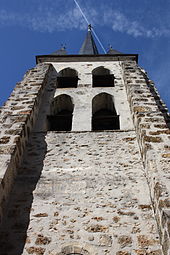St-Martin (Jouy-en-Josas)
The Catholic parish church of Saint-Martin in Jouy-en-Josas , a parish in the Yvelines department in the French region of Île-de-France , was built in the mid-16th century on the foundations of a previous church of the 13th century. The most valuable piece of equipment in the church is the sculpture La Diège , a Madonna and Child from the 12th century. In 1950, the church consecrated to St. Martin was added to the list of architectural monuments in France as Monument historique .
history
The place Jouy-en-Josas is mentioned as Gaugiaco in the inventory of the abbey of Saint-Germain-des-Prés as early as the 11th century . It is believed that the place already had a church at that time. The oldest parts of today's church, the substructure of the tower and the side walls of the choir , go back to a church building from the 13th century. This church fell into disrepair in the 14th and 15th centuries. Century following the plague epidemics and the Hundred Years War . At the end of the 15th century, work began on rebuilding the church, which was consecrated in 1549 .
architecture
Exterior construction
On the west facade is the Renaissance portal framed by two columns and crowned by a triangular gable . The originally free-standing bell tower rises above the south aisle.
inner space
The nave consists of a main and a side aisle. Both naves are covered by ribbed vaults and are separated from each other by large pointed arches .
On the walls of the nave there is a painted frieze , a so-called liter funéraire (mourning ribbon), on which the coats of arms of important patrons such as the Escoubleau de Sourdis family can be seen.
Leaded glass window
The lead glass windows of the nave were created by Paul Nicod in 1858 . On the north side they place St. Martin, the patron saint of the Church, St. Rochus and St. Sebastian . One window on the south side shows the apostles James the Younger , Simon , Bartholomäus and Andreas . Another window is dedicated to the evangelists Luke , John , Mark and Matthew . A window on the north side has episodes of the legend of Martin on the subject: Martin shares his cloak with a beggar, Martin is elected bishop, Martin heals a man possessed and Martin is taken to heaven. The opposite window on the south side shows stations from the life of Mary: Annunciation , Flight into Egypt , Adoration by the Shepherds and Coronation of Mary .
The two modern choir windows were created in 1986 in the Annie and Patrick Confetti workshop in Les Loges-en-Josas.
organ
The present organ was installed in 1872 by the organ builder John Abbey using older parts. 1974–1975 the instrument was restored and expanded by Adrien Maciet. The instrument has 17 stops on two manual works and a pedal.
|
|
|
||||||||||||||||||||||||||||||||||||||||||||||||||||||||||||||
- Coupling : II / I, I / P, II / P.
Furnishing
- Four wood-carved choir stalls from the 15th century have been preserved.
- On the top wall of the choir is a stone sculpture from the 16th century depicting St. Martin sitting on a horse sharing his coat with a beggar.
- The clay sculpture of John the Baptist dates from the 17th century.
- The marble sculpture depicting St. Sebastian is dated 1694 and is ascribed to Pierre Puget .
- The wood-carved confessional dates from the 18th century.
La Diège
The oldest and most valuable piece of equipment in the church is the wooden Madonna sculpture La Diège from the 12th century. The name is derived from the Latin name Dei Genitrix (Mother of God). This figure was originally worshiped in a chapel in the hamlet of Viltain, south of Jouy-en-Josas, and has long been a pilgrimage destination . When the chapel fell into disrepair around 1780, the sculpture was moved to the Saint-Martin church. During the French Revolution , it was brought back to Viltain and hidden in a walled-up window. In 1850 it was discovered during construction and brought back to the Saint-Martin church in Jouy-en-Josas. In 1863 it was restored under the direction of Eugène Viollet-le-Duc .
The frontal representation of Mary, the strict folds of her veil and her cloak are typical of a Romanesque Madonna figure. The baby Jesus holds the globe crowned with a cross in his left hand, his right hand is raised in blessing. The presentation of the baby Jesus is unusual, no longer depicted as a small child and standing in front of Mary, being carried on hands by two angels.
literature
- Jean-Marie Pérouse de Montclos (ed.): Le Guide du Patrimoine. Ile-de-France . Hachette, 2nd edition, Paris 1994, ISBN 2-01-016811-9 , pp. 352-353.
- Georges Poisson (ed.): Dictionnaire des Monuments d'Île de France. Éditions Hervas, Paris 2001, ISBN 2-84334-002-0 , pp. 420-421.
- Église Saint-Martin Jouy en Josas. Association Saint-Martin leaflet, Jouy-en-Josas 2000.
Web links
- PA00087463 Église Saint-Martin de Jouy-en-Josas in the Base Mérimée of the French Ministry of Culture (French)
- Mairie de Jouy-en-Josas: Église Saint-Martin (French) ( Memento from June 30, 2012 in the Internet Archive )
- Église Saint-Martin topic topos (French)
Individual evidence
Coordinates: 48 ° 45 '48.5 " N , 2 ° 10' 5.2" E










